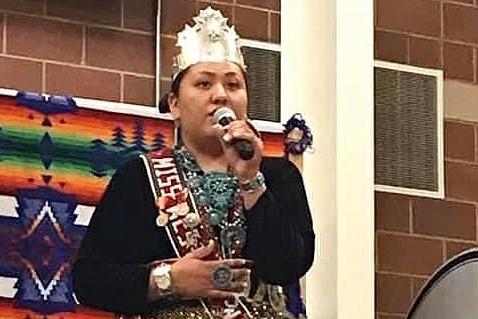Trump Can’t Mask His Message to Indian Country: 'Live and Let Die'
- Opinión

The COVID-19 pandemic has hit the Diné/Navajo people hard, inflicting the highest per capita infection rate in the country after New York, New Jersey, Connecticut and Massachusetts. The Navajo Nation is the largest reservation in the country, larger than West Virginia, straddling Arizona, New Mexico, Colorado and Utah. Half of the over 300,000 enrolled members reside on the reservation. Navajo President Jonathan Nez has issued some of the strongest stay-at-home measures in the country, including a weekday evening curfew and a complete, stay-at-home curfew for the entire weekend. Nearby Gallup, New Mexico, with a large Diné population, has enacted a complete lockdown, with the National Guard prohibiting entry.
As of May 5, despite these efforts, there were 2,559 confirmed COVID-19 cases on the Navajo Nation and 79 deaths. Among the victims, 28-year-old Valentina Blackhorse, a beloved champion of Navajo culture and a community leader. She left behind her partner, Robby Jones, and their 1-year-old daughter, Poet.
“She really loved her family — her parents, her sisters, her nieces and nephews. She loved her elderly. She loved children,” Jones said Tuesday on the Democracy Now! news hour. “She was a kind and hardworking lady, and she was warmhearted. She would do anything for her family.”
Jones is a detention officer with the Navajo Department of Corrections, and contracted COVID-19 at work. “When she was taking care of me, I guess she contracted it,” he said. “She started showing symptoms — shortness of breath, body aches, loss of taste and smell. By the time I started feeling better, … that’s when she started feeling sick.”
Valentina Blackhorse tested positive for COVID-19 on April 22. She died the next day. She had won numerous pageants, being named Miss Western Navajo and Miss Diné College, among others, and hoped to run for office in the Navajo Nation government one day.
Dr. Michelle Tom, a member of the Navajo Nation, is a family physician in Winslow, Arizona, just across the Navajo reservation line. She spoke about Valentina’s death on Democracy Now!: “It’s a reflection of what we’re going through as a people, and it correlates with what this virus can do to our young and someone who was very motivated, loved our culture, spread our rich and strong culture, and our language. That’s what we’re trying to fight for,” she said, adding, “She was going to lead our next generation. It was a hard loss for our community.”
The Navajo Nation, along with the nearby Hopi, Pueblo, Zuni and Gila River indigenous communities, have endured despite centuries of genocide, oppression and systemic racism and poverty. The novel coronavirus pandemic is afflicting them disproportionately, as it has African American and Latinx populations across the U.S. Access to water is challenging on the Navajo reservation.
“That’s from a long state of histories with treaties and our relationship with the [federal] government,” Dr. Michelle Tom explained. “Our infrastructure for water has never been at the capacity where we can provide water for everyone on the reservation. So, you’re telling people to wash your hands for 20 seconds, and yet people are trying just to get water just to drink and to cook with.”
President Donald Trump made a rare trip Tuesday, visiting an Arizona N95 mask factory, where he ignored factory rules by not wearing a mask. Guns ‘N Roses blared from a factory sound system, playing the song “Live and Let Die.” It’s not clear if it was a coincidental music choice or not.
Trump also met with elected officials, including Navajo Nation Vice President Myron Lizer. The Navajo Nation joined a lawsuit filed by numerous native tribes against Treasury Secretary Steven Mnuchin, for his abject failure in disbursing $8 billion promised to Native American tribes in the CARES Act.
“The amount of money that’s being sent to ‘Indian country,’ as we call it, is the largest amount in the history of the U.S. And you deserve it. And you’ve been through a lot,” Trump said to VP Lizer. “The Navajo Nation will soon receive over $600 million. That’s a lot. Should I renegotiate that? Can we renegotiate that?” (Laughter.)
There was no laughter back on the Navajo Nation. “Today, the federal government announced that they intend to release a portion of funds appropriated by Congress over one month ago to tribes to help fight COVID-19, but I’ll believe it when I see it,” President Jonathan Nez, who himself tested positive for the virus, replied. “We couldn’t sit around and wait for those dollars, so we’ve had boots on the ground in nearly 20 communities giving out food, water, firewood, protective masks and other supplies … We lost many of our beloved relatives and family members to this virus, but our teachings also tell us to move forward. We will and we are.”
The original content of this program is licensed under a Creative Commons Attribution-Noncommercial-No Derivative Works 3.0 United States License. Please attribute legal copies of this work to democracynow.org.
Del mismo autor
- Putin’s war on Ukraine could spark a nuclear catastrophe 04/03/2022
- La persecución de Biden contra Julian Assange 18/01/2022
- Biden’s persecution of Julian Assange 06/01/2022
- ¿Reconstruir mejor o construir más bombas? La elección es clara 13/12/2021
- Facebook Papers: cumplicidade no ódio, nas mentiras e na violência 28/10/2021
- Es hora de eliminar a Facebook de nuestra lista de amigos 11/10/2021
- El espía que se metió en tu teléfono 20/09/2021
- De Kabul al río Bravo, Estados Unidos crea crisis de refugiados 31/08/2021
- Después de décadas de guerra, el pueblo afgano merece la paz 23/08/2021
- Código rojo: la emergencia climática exige una acción inmediata 16/08/2021
Clasificado en
Clasificado en:
Pandemia
- Gabriela Ramírez Mendoza 07/02/2022
- Jyotsna Singh 06/02/2022
- Gabriela Ramírez Mendoza 06/02/2022
- Richa Chintan 10/01/2022
- Isaac Enríquez Pérez 03/01/2022
